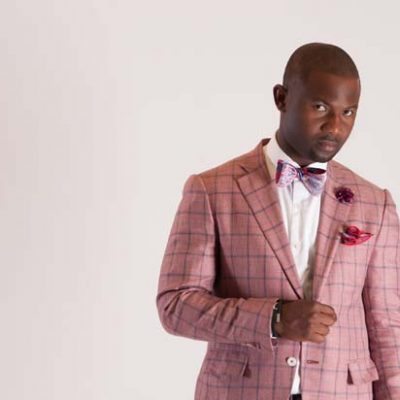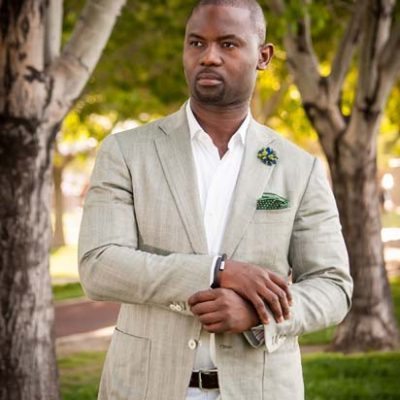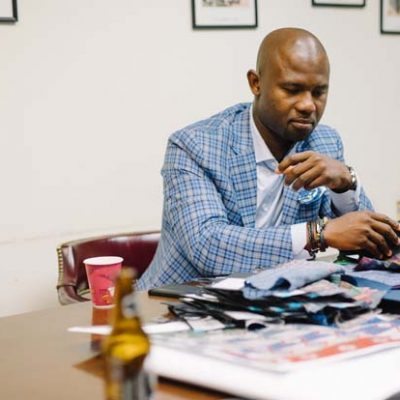
Known internationally as “the Bow tie King,” a Union County-based designer’s colorfully innovative creations grace boldface names
by Laura D.C. Kolnoski
Edward Armah’s American success story begins in Ghana, where his grandparents owned a vocational sewing school. His parents, professionals with the Ministry of Finance in a family of doctors and lawyers, “made sure none of the kids got into that business, but I was called,” the men’s fashion designer recalled. His passion for clothing began during summers picking needles and thread from the floor with a magnet, which led to familiarity with sewing machines.
Against his parent’s wishes, Armah left college and moved to England in 1998, getting a job as a delivery man for a Savile Row clothier, while studying menswear and increasing his knowledge and expertise. When London could not quench his America, landing a position as stylist and personal shopper at Neiman Marcus Short Hills. There, he studied the styles, tastes, and lifestyles of customers. One was Barry Cope (a.k.a. radio show host Elvis Duran), who needed proper attire to take him from hosting the local Z-100 Jingle Ball to Los Angeles on short notice. Armah designed what he needed. Another client, Michael Chertoff, former United States Secretary of Homeland Security under Presidents George W. Bush and Barack Obama, needed an entire wardrobe to take him from New Jersey attorney to Washington, D.C. honcho.
In addition to working with every large brand the upscale department store carried, Armah got to attend high-profile events and meet an array of customers who lived in different climates, learning to advise them in any haberdashery situation. Both Zegna and Brioni asked him to become a representative, and he was also invited to attend Pitti Immagine Uomo (a multi-show event for menswear and men accessories) in Florence, Italy, where he realized the industry was far more than what he saw at the store level.
“I was curious, so I went the following season on my own,” Armah said. “I started losing passion for what I was doing in the stores and wanted to be more creative and have more creative control.” He moved to New York City and took a position with Saks Fifth Avenue until he was approached by Oxxford Clothes, manufacturer of hand-tailored suits, to represent their brand at all Saks stores. Soon, Armah was traveling to Chicago and Los Angeles, hosting events, product seminars, and trunk shows.
What happened next became the catalyst that propelled Armah into the men’s fashion stratosphere; he was sent to fit performer Andre’ Benjamin of Outkast for the Grammy Awards, and designed a special fabric for the star. What looked like pinstripes was, upon closer inspection, Benjamin’s name. The two men became friends. When Benjamin directed a video, Armah met Farnsworth Bentley (Sean Combs’ former assistant known for his bow ties), Jay-Z, (whom he eventually created a Grammy outfit for), and Chris Brown. After Brown’s infamous altercation with then-girlfriend Rihanna, his stylist came to Armah to help dress the singer for his appearance on Larry King Live. Armah offered his own turquoise bow tie, which became known as the “apology tie” after Brown wore it on the show.
Armah’s superiors were not happy.
“The next day I was called to human resources and suspended for conflict of interest,” Armah said. “So, I figured, I’ve done this for enough people; let me try to do it on my own and see if it works.” About that time, the economy tanked and his wife, who was pregnant, was laid off by Merrill Lynch. Armah sought advice from a friend who owned a New Jersey necktie factory, who told him, “Everybody knows you and you have something different,” so the young entrepreneur cashed in his 401k (“the scariest part”), rented out half his house, and asked his wife to give him one year to make his venture work.
Armah reconnected with his Neiman Marcus boss, telling her all that had transpired in his career since he left the venerable retailer. She put Armah on a conference call to Neiman’s Dallas headquarters. The next thing he knew, he was on an plane to Texas for a presentation.
“The market was bad, but I told them that every men’s store has the same bow ties,” he related. “What I brought in was totally new and fresh.” Armah’s Butterfly Bowties were tested in four locations where the designer travelled, where he met customers and talked to staff who embraced his styles, patterns, and colors. His first trunk show took place in Short Hills on the night the Christmas tree was lit there. He sold out, so Neiman’s buyer increased Butterfly Bowties’ presence to 15 stores.
Armah’s bow ties are easy to wear. The “secret” is a small hook at the back, along with a design that allows them to be worn four different ways (including reversibly). His website includes step-by-step instructions and a video on the proper way to tie a bow tie, with related fashion design tips.






